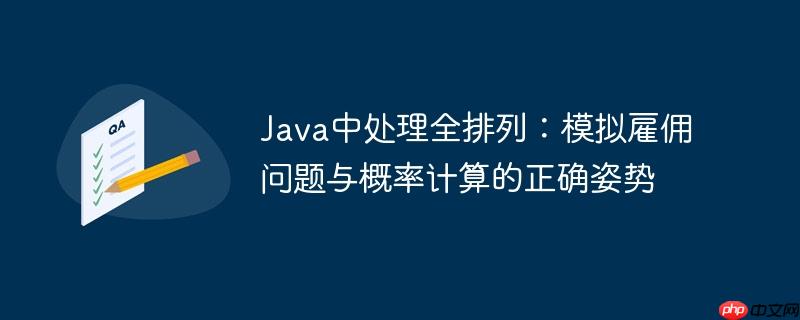
在计算机科学和算法设计中,我们经常需要处理数据的各种排列。一个典型的应用场景是模拟实验或计算概率。本教程将以一个经典的“雇佣问题”为例,展示如何生成一个集合的所有排列,并对每个排列应用特定的逻辑,最终计算出满足特定条件的排列所占的比例(即概率)。
问题的核心在于:给定一组按排名顺序的候选人(例如1到n),我们按随机顺序面试他们。每面试一个候选人,如果他比之前面试过的所有候选人都优秀(排名更低),我们就雇佣他。我们的目标是计算在所有可能的面试顺序(即所有排列)中,恰好雇佣了两次的概率。
原始代码尝试通过生成所有排列来解决此问题,但在将这些排列传递给核心的雇佣逻辑时,出现了一个常见的错误:将所有排列扁平化处理,导致无法对单个排列进行独立分析。
为了理解并修正代码,我们首先分析其核心组件:
这是模拟雇佣逻辑的关键方法。它接收一个 int[] 数组作为候选人序列(一个排列),并返回雇佣的次数。
立即学习“Java免费学习笔记(深入)”;
public static int hireAssistant1(int[] arr, int n) {
ArrayList<Integer> hired = new ArrayList<Integer>();
// 第一个候选人总是被雇佣
int best = arr[0];
hired.add(best);
// 遍历后续候选人
for (int i = 1; i < n; i++) {
// 如果当前候选人比目前为止的最佳候选人更优秀(排名更低),则雇佣
if (arr[i] < best) {
best = arr[i];
hired.add(best);
}
}
return hired.size(); // 返回雇佣的总人数
}该方法的核心思想是:始终雇佣第一个面试的候选人,之后只雇佣比当前已雇佣的最佳候选人更优秀的候选人。
此方法及其辅助方法 permuteHelper 负责生成给定数组的所有可能排列。它返回一个 List<List<Integer>>,其中每个内部 List<Integer> 代表一个独立的排列。
public List<List<Integer>> permute(int[] arr) {
List<List<Integer>> list = new ArrayList<>();
permuteHelper(list, new ArrayList<>(), arr);
return list;
}
private void permuteHelper(List<List<Integer>> list, List<Integer> resultList, int[] arr) {
// 递归终止条件:当resultList的长度等于原始数组长度时,表示一个完整的排列已生成
if (resultList.size() == arr.length) {
list.add(new ArrayList<>(resultList)); // 将当前排列添加到结果列表中
} else {
// 遍历原始数组中的每个元素
for (int i = 0; i < arr.length; i++) {
// 如果当前元素已在resultList中,则跳过(避免重复)
if (resultList.contains(arr[i])) {
continue;
}
resultList.add(arr[i]); // 将元素添加到当前排列中
permuteHelper(list, resultList, arr); // 递归调用
resultList.remove(resultList.size() - 1); // 回溯:移除最后一个元素,尝试其他路径
}
}
}原始 main 方法中的核心问题在于对 permute 方法返回结果的处理:
public static void main(String[] args) {
Assignment8 pa = new Assignment8();
int n = 6;
List<List<Integer>> p = pa.permute(makeArray(n)); // p 包含所有独立的排列
List<Integer> list = listToList(p); // 错误:将所有排列扁平化为一个大列表
System.out.println("N = 6");
methodThreePerm(list, n); // 将扁平化列表传递给处理方法
}这里的 listToList(p) 调用是问题的根源。例如,如果 n=3,permute 可能会返回 [[1,2,3], [1,3,2], [2,1,3], ...]。经过 listToList 后,list 可能会变成 [1,2,3,1,3,2,2,1,3,...]。
随后,methodThreePerm 接收这个扁平化的 List<Integer>,并将其转换为一个巨大的 int[] arr。当 hireAssistant1(arr, n) 被调用时,它会将这个巨大的数组当作一个单一的、长度为 n 的序列来处理,但实际上这个数组的长度远大于 n,且包含了多个排列的拼接。这导致 hireAssistant1 无法正确地模拟单个排列的雇佣过程,从而使最终的概率计算结果完全错误。
hireAssistant1 方法期望的输入是一个独立的排列(例如 [1,2,3] 或 [3,1,2]),而不是所有排列拼接在一起的巨大序列。
解决这个问题的关键在于,我们应该直接利用 permute 方法返回的 List<List<Integer>> 结构,逐个遍历每个独立的排列,并对其应用 hireAssistant1 逻辑。
正确的处理流程如下:
以下是修正后的 main 方法示例,它直接在 permute 的结果上进行迭代,确保每个排列都被正确处理:
import java.util.ArrayList;
import java.util.List;
import java.util.stream.Collectors; // For listToList, though it's removed in solution
public class PermutationHiring {
// 辅助方法:创建包含1到n的数组
public static int[] makeArray(int n) {
int arr[] = new int[n];
for (int i = 0; i < arr.length; i++) {
arr[i] = i + 1;
}
return arr;
}
// 雇佣模拟方法
public static int hireAssistant1(int[] arr, int n) {
// ArrayList<Integer> hired = new ArrayList<Integer>(); // 实际上不需要存储被雇佣者,只需计数
int hires = 0;
if (n == 0) return 0; // 空数组没有雇佣
if (n == 1) return 1; // 只有一个候选人,必然雇佣一次
int best = arr[0];
hires = 1; // 第一个候选人总是被雇佣
for (int i = 1; i < n; i++) {
if (arr[i] < best) {
best = arr[i];
hires++;
}
}
return hires;
}
// 计算阶乘
public static int factorial(int n) {
if (n < 0) throw new IllegalArgumentException("Factorial is not defined for negative numbers.");
if (n == 0 || n == 1) return 1;
int result = 1;
for (int i = 2; i <= n; i++) {
result *= i;
}
return result;
}
// List<Integer> 转换为 int[]
static int[] toIntArray(List<Integer> list) {
int[] ret = new int[list.size()];
for (int i = 0; i < ret.length; i++)
ret[i] = list.get(i);
return ret;
}
// 生成所有排列的核心逻辑
public List<List<Integer>> permute(int[] arr) {
List<List<Integer>> list = new ArrayList<>();
permuteHelper(list, new ArrayList<>(), arr);
return list;
}
private void permuteHelper(List<List<Integer>> list, List<Integer> resultList, int[] arr) {
if (resultList.size() == arr.length) {
list.add(new ArrayList<>(resultList));
} else {
for (int i = 0; i < arr.length; i++) {
if (resultList.contains(arr[i])) {
continue;
}
resultList.add(arr[i]);
permuteHelper(list, resultList, arr);
resultList.remove(resultList.size() - 1);
}
}
}
public static void main(String[] args) {
PermutationHiring ph = new PermutationHiring(); // 实例化类以调用非静态方法
int n = 6;
// 生成所有排列
List<List<Integer>> allPermutations = ph.permute(makeArray(n));
int hiresTwoCount = 0; // 统计雇佣次数恰好为2的排列数
int totalPermutations = factorial(n); // 总排列数
// 遍历每一个独立的排列
for (List<Integer> permutation : allPermutations) {
int[] currentPermutationArray = toIntArray(permutation);
int hires = hireAssistant1(currentPermutationArray, n);
if (hires == 2) {
hiresTwoCount++;
}
}
double probability = (double) hiresTwoCount / totalPermutations;
System.out.println("N = " + n);
System.out.println("雇佣次数恰好为2的排列数: " + hiresTwoCount);
System.out.println("总排列数 (n!): " + totalPermutations);
System.out.println("雇佣次数恰好为2的概率: " + probability);
// 原始答案中提供的Method 1,用于计算不同的概率(例如,期望雇佣次数的某个变体)
// 注意:这个方法计算的结果与“雇佣恰好两次”的概率不同。
// static void methodOne以上就是Java中处理全排列:模拟雇佣问题与概率计算的正确姿势的详细内容,更多请关注php中文网其它相关文章!

每个人都需要一台速度更快、更稳定的 PC。随着时间的推移,垃圾文件、旧注册表数据和不必要的后台进程会占用资源并降低性能。幸运的是,许多工具可以让 Windows 保持平稳运行。

Copyright 2014-2025 https://www.php.cn/ All Rights Reserved | php.cn | 湘ICP备2023035733号